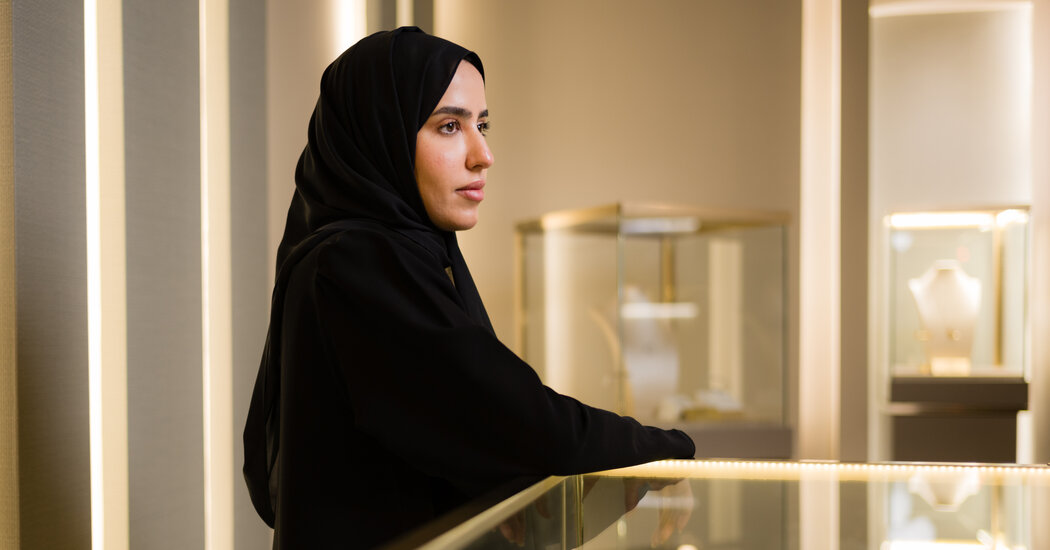When Fatma Al-Mohannadi founded De Trove jewelry, it was the fruition of a teenage dream.
“I always had a passion for drawing jewelry, and I thought maybe I should just start my own line,” Ms. Al-Mohannadi, 35, said during a recent interview at her boutique in Doha’s Pearl neighborhood. “So I pursued my passion and launched my first line in 2018.”
That initial collection, called Almahfa, reflected her goal of making jewelry that celebrated Qatari culture and history but with designs that could be worn throughout the day. In Qatar, traditional jewelry such as necklaces, bracelets and face masks, called battoulahs, can be extremely heavy and uncomfortable for extended wear.
“My first idea was to mix the heritage and culture of this region, but with a less heavy gold,” she explained. “That way women can wear it as much as they want.”
Ms. Al-Mohannadi also noted that some traditional short necklaces — around 30 centimeters, or about 12 inches, long — were obscured by abayas, the long gowns worn here by Muslim women. “My collection includes long necklaces so that women can wear them with an abaya, but outside of the abaya,” she said. “It’s not too heavy, so it won’t scratch. And it looks modern and not too heavy. It’s elegant.”
“In Qatari fashion,” Shaikha Hamad, a Qatari designer of traditional women’s clothing, wrote in an email, “a trend has emerged that blends jewelry with abayas and other traditional attire, and Fatma masterfully combines contemporary sophistication with our cultural heritage. I feel like De Trove’s pieces transition from day to evening seamlessly.”
De Trove was a name that Ms. Al-Mohannadi devised with the help of a branding agency to give the business a French ambience. But it included the English word “trove,” which, she said, “means something to me, like you always keep something that has value in a nice place.”
In addition to designing for a local audience, Ms. Al-Mohannadi has been focused on ensuring that De Trove’s production is done in Qatar. “All of the gold is processed in Qatar,” she said. “I go to the Gold Souk here in Doha and give them my design, then we make a 3-D version of it. There are about eight craftsmen in the Gold Souk who I work with on all my pieces.”
Her debut line, Almahfa, a regional Arabic word for a type of hand fan, included necklaces, earrings, bracelets and rings in 18-karat gold; turquoise imported mostly from India; and pearls.
“The pearls are all local,” Ms. Al-Mohannadi said as she displayed several pieces, including a necklace that linked eight small fan shapes. “This is still my best seller.”
The Moon collection, introduced in 2018, incorporates the Islamic imagery of a crescent moon and star found on flags throughout the Muslim world (Turkey, Libya and Algeria, among others). The collection’s bracelet has a gap between a star shaped in 18-karat gold with a white enamel center that is produced in the Gold Souk, and a crescent moon accented with a row of 0.36-carat diamonds. The wrist slips through that gap between the star and the moon.
“This is all about Islamic culture and heritage, and the star is also part of Islamic architecture,” she explained. “When I designed it, it felt like something new for Ramadan, but not too heavy.”
The Moon pendant and ring have sold out every year during the Islamic holy month, so Ms. Al-Mohannadi plans to increase production next year.
De Trove now has 10 collections, with prices from 1,000 Qatari rial, or about $270, to 18,500 rial. In addition to the boutique, the brand is sold through its website and through Instagram and WhatsApp. Ms. Al-Mohannadi declined to disclose the brand’s annual sales.
Tamadur Tariq Al Shamlan, a coordinator for the annual celebration Qatar Years of Culture, wrote in an email that she first came across De Trove at a local art fair and that “the brand’s focus on craftsmanship was evident in every piece.”
“It’s refreshing to find a brand that prioritizes quality and style,” she added. “I particularly appreciate the varied choice of ring styles because that’s my go-to piece of everyday jewelry.”
Ms. Al-Mohannadi said she took ideas not only from the imagery of the Muslim world but also from nature.
“The Flower line is my latest collection from 2023, which duplicates the logo of De Trove,” she said — the logo, which she designed herself, resembled a cross between a flower and a faceted diamond. “This looks like vintage jewelry, and I added diamonds, rubies and blue sapphires. There is a separate version with just one flower made of jade.”
Ms. Al-Mohannadi said that one of her most popular lines was the Letters collection, which had rings and necklaces shaped to look like Arabic letters and numerals, often with several shapes intertwined.
“I always wear two,” she said, displaying her hand. “One is the first letter of my name. Another one is ‘love’ in Arabic. It’s good to have something like love or faith near me.”
She has done custom designs, and some clients have commissioned their initials or special messages. “I did one for a client for her engagement day,” she said. “His name and her name. I joined them. It’s a souvenir.”
Using letters in jewelry is not an original idea, Ms. Al-Mohannadi said, but she liked to think that she had added her own touch to the swirling beauty of Arabic calligraphy. It was one of her early inspirations as a teenager, sketching ideas at home.
“How I do this differently is the way they can wrap around the finger, plus the addition of diamonds and the engraving on the inside,” she said. “Arabic calligraphy is so florid and beautiful, so it lends itself to being designed to move around the finger. It’s so open to interpretation.”







